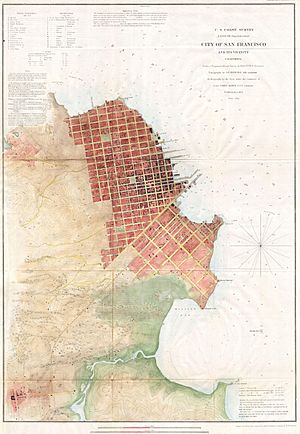Mission Bay (San Francisco) facts for kids
Mission Bay was once a large bay and a river mouth on the west side of San Francisco Bay. It was located between Steamboat Point and Potrero Point. Today, most of the bay has been filled in with land. It is now the area where the Mission Bay neighborhood of San Francisco is built.
Contents
History of Mission Bay
Mission Bay used to be a lagoon, which is a shallow body of water separated from a larger body of water. This lagoon was part of a big salt marsh that covered over 500 acres. It had water all year round because of the tides.
Animals and Nature in the Bay
This area was a perfect home for many different kinds of water fowl. You could find lots of ducks, geese, herons, egrets, ospreys, and gulls living there. It was a safe place for these birds to live and raise their young.
Native American Life in Mission Bay
The Native American tribes who lived in this area were the Costanoan people. They spoke eight different languages, showing that there were many different groups. The Patwin people were very common in the Bay area. They lived there for more than 5,000 years. Sadly, when European immigrants arrived in the early 1800s, they brought new diseases. These diseases caused many Native Americans to become very sick, and their population greatly decreased.
How Mission Bay Changed Over Time
From the 1850s, people started using the Mission Bay area for different jobs. They built and repaired ships there. They also used it for butchery and making meat products. People even fished for oysters and clams in the bay.
In the mid-1800s, people began to fill in Mission Bay. They wanted to make the land suitable for building. Like much of San Francisco's shoreline, Mission Bay became a convenient place to dump trash from building projects. It also received debris from the terrible 1906 earthquake.
As the marsh was filled in and became more stable, the area quickly turned into an industrial district. With the arrival of the railroad, Mission Bay became home to many businesses. These included shipyards, canneries (places where food is canned), a sugar refinery, and many warehouses.


